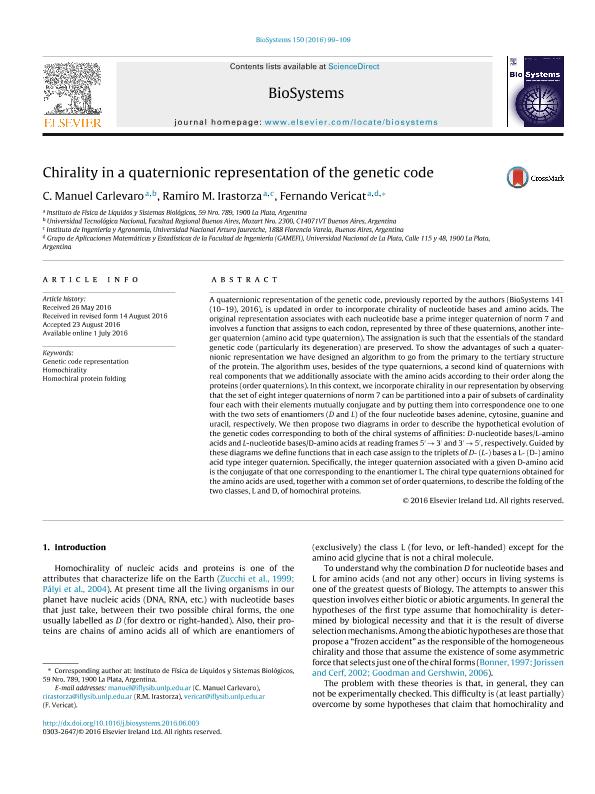Artículo
Chirality in a quaternionic representation of the genetic code
Fecha de publicación:
12/2016
Editorial:
Elsevier
Revista:
Biosystems
ISSN:
0303-2647
Idioma:
Inglés
Tipo de recurso:
Artículo publicado
Clasificación temática:
Resumen
A quaternionic representation of the genetic code, previously reported by the authors (BioSystems 141(10?19), 2016), is updated in order to incorporate chirality of nucleotide bases and amino acids. Theoriginal representation associates with each nucleotide base a prime integer quaternion of norm 7 andinvolves a function that assigns to each codon, represented by three of these quaternions, another inte-ger quaternion (amino acid type quaternion). The assignation is such that the essentials of the standardgenetic code (particularly its degeneration) are preserved. To show the advantages of such a quater-nionic representation we have designed an algorithm to go from the primary to the tertiary structureof the protein. The algorithm uses, besides of the type quaternions, a second kind of quaternions withreal components that we additionally associate with the amino acids according to their order along theproteins (order quaternions). In this context, we incorporate chirality in our representation by observingthat the set of eight integer quaternions of norm 7 can be partitioned into a pair of subsets of cardinalityfour each with their elements mutually conjugate and by putting them into correspondence one to onewith the two sets of enantiomers (D and L) of the four nucleotide bases adenine, cytosine, guanine anduracil, respectively. We then propose two diagrams in order to describe the hypothetical evolution ofthe genetic codes corresponding to both of the chiral systems of affinities: D-nucleotide bases/L-aminoacids and L-nucleotide bases/D-amino acids at reading frames 5→ 3and 3→ 5, respectively. Guided bythese diagrams we define functions that in each case assign to the triplets of D- (L-) bases a L- (D-) aminoacid type integer quaternion. Specifically, the integer quaternion associated with a given D-amino acidis the conjugate of that one corresponding to the enantiomer L. The chiral type quaternions obtained forthe amino acids are used, together with a common set of order quaternions, to describe the folding of thetwo classes, L and D, of homochiral proteins.
Palabras clave:
Genetic Code Representation
,
Homochiraslity
,
Homochiral Protein Folding
Archivos asociados
Licencia
Identificadores
Colecciones
Articulos(IFLYSIB)
Articulos de INST.FISICA DE LIQUIDOS Y SIST.BIOLOGICOS (I)
Articulos de INST.FISICA DE LIQUIDOS Y SIST.BIOLOGICOS (I)
Citación
Carlevaro, Carlos Manuel; Irastorza, Ramiro Miguel; Vericat, Fernando; Chirality in a quaternionic representation of the genetic code; Elsevier; Biosystems; 150; 12-2016; 99-109
Compartir
Altmétricas




